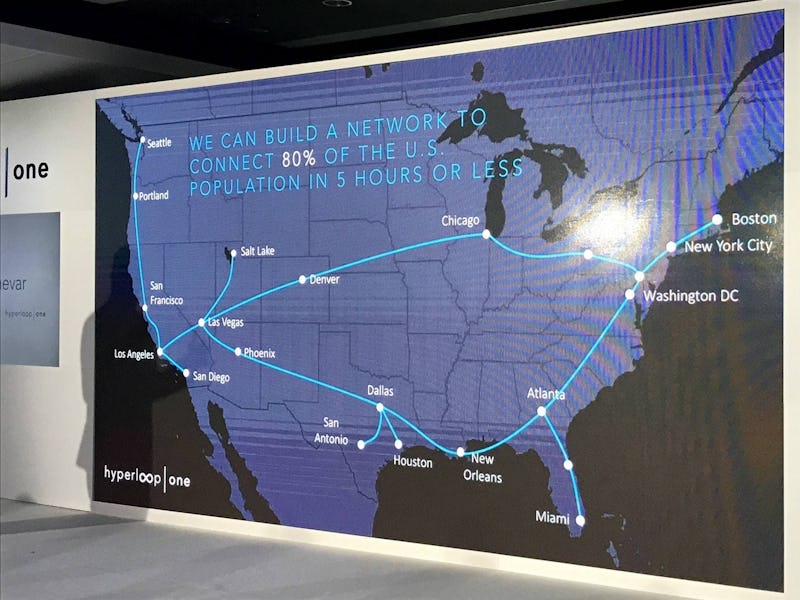How Realistic Is This Hyperloop One Future Map of the U.S.?

Hyperloop One unveiled an ambitious proposal earlier this month to link up the contiguous United States. Rob Lloyd, the company’s CEO, hosted an event in Washington, D.C. to outline 11 proposed hyperloop projects, during which he displayed a hypothetical network map that would link 80 percent of the population to within five hours’ travel time.
It sounds fantastic, but unfortunately, a network like the one shown is likely decades ahead into the future.
The vacuum-sealed tube, first outlined in a proposal by Elon Musk in 2013, shoots pods through a tube at a theoretical maximum speed of 700 miles per hour. Several companies are working on the technology, but Hyperloop One is different: it’s the first one to build a hyperloop track.
The 1,640-foot DevLoop test track, located 30 minutes away from Las Vegas in the Nevada desert, measures 10.8 feet in diameter and weighs over two million pounds. It’s the first step toward building a functional network: the company is hosting a global design competition with 35 semifinalists competing for the chance to bring their dream to life. These initial plans could one day transform into a global hyperloop network that may look something like this:
An artist's impression of a global metro network.
“It’s not for the elite, it’s for every citizen, and we think we can transform people’s lives, economies, commerce, and logistics,” Lloyd said at the event. “That’s the mission we’ve signed up for.”
But while small-scale projects in the desert are possible, a national network would bring a whole different set of problems. Phil Mason, a scientist at the Academy of Sciences of the Czech Republic who runs the thunderf00t YouTube channel, describes it to Inverse as “trying to walk before you can run.”
“Proposing a vacuum container around 20,000 miles in length, as in the proposal, is comical,” Mason says.
The problem is that the Nevada track currently places vacuum pumps along the track around every 100 feet. Not only would a national network pose new problems, airtight containers like the International Space Station and military submarines cost billions.
“This is all before you worry about firing things down such a tube at the speed of a bullet,” Mason says.
That was probably best exemplified at a competition in January. Musk’s space exploration firm SpaceX held a hyperloop event, inviting 30 teams to design a pod and run it through a 4,150 feet vacuum-sealed tube. Delft University reached the highest speeds out of the three teams that competed in the grand final, but even then their creation only reached around 55 miles per hour. Flinging passenger pods at speed down a tube is not as easy as it seems.
A vacuum-sealed train sounds cool, but using it for your next trip to Los Angeles? Don’t hold your breath.